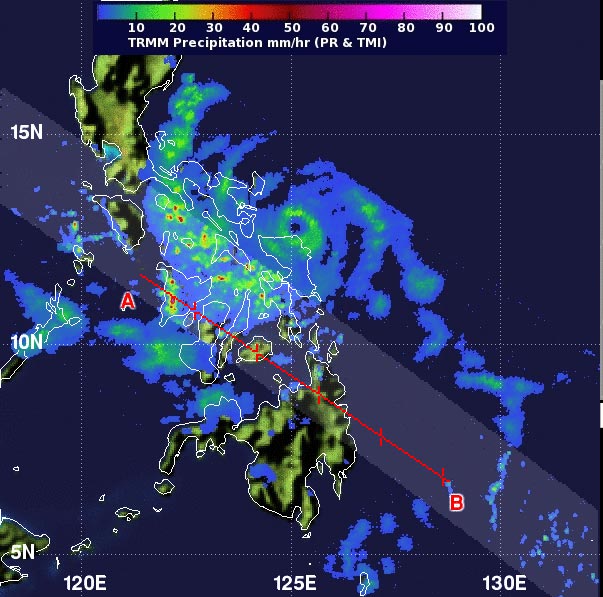NASA Sees Typhoon Rammasun's Eye Staring at Visayas, Philippines

TRMM satellite passed over Rammasun on July 15 at 12:10 a.m. EDT and found moderate rainfall (35 mm/1.4 in/hr) around the center and moderate to heavy rainfall (50 mm/2 in/hr) over the central and northern Philippines. Image Credit: SSAI/NASA, Hal Pierce
Typhoon Rammasun was making landfall in the Visayas region. Visayas is located in the central Philippines.
The Tropical Rainfall Measuring Mission or TRMM satellite passed over Rammasun on Tuesday, July 15, 2014 at 04:10 UTC (12:10 a.m. EDT) and measured rainfall occurring throughout the storm.
TRMM found moderate rainfall (about 35 mm)/1.4 inches per hour) around the center of circulation and moderate to heavy rainfall (50 mm/2 inches per hour) over the central and northern Philippines in the western quadrant of Rammasun.
When NASA's Aqua satellite flew over Typhoon Rammasun on July 15 at 05:00 UTC (1 a.m. EDT) the Moderate Resolution Imaging Spectroradiometer instrument known as MODIS took a visible image of the storm.
The MODIS image showed Rammasun's eye just east of the Visayas region. Rammasun's clouds stretched over the entire country and west into the South China Sea.
Another instrument aboard Aqua took an infrared picture of Rammasun's cloud top temperatures. The Atmospheric Infrared Sounder gathered temperature data that showed cloud top temperatures exceeded -63F/-52C over the northern and central Philippines and in a band of thunderstorms southeast of the center of circulation over the Philippine Sea.
Cloud top temperatures that cold indicate cloud tops high into the troposphere with the potential to produce heavy rainfall. That heavy rainfall was confirmed by NASA's TRMM satellite measurement just 49 minutes earlier when that satellite passed over the Philippines.
On July 15 at 0900 UTC (5 a.m. EDT), Typhoon Rammasun's maximum sustained winds were near 100 knots (115.1 mph/185.2 kph). At that time the center of the storm was closing in on the island of Sorsogon, Philippines. It was centered near 13.2 north latitude and 124.1 east longitude, also about 236 nautical miles (271.6 miles/437.1 km) southeast of Manila. Rammasun is moving to the northwest at 9 knots (10.3 mph/16.6 kph) and is forecast to pass close to Manila early on July 16 (UTC).
The Joint Typhoon Warning Center forecasters expect Rammasun to weaken moving over the Philippines and then re-intensify after re-emerging over the South China Sea because of the warm sea surface temperatures there. Rammasun is expected to be a typhoon when it makes a second landfall over northern Hainan Island, China on July 18 before a final landfall in northern Vietnam.
Text credit: Rob Gutro
NASA's Goddard Space Flight Center
Media Contact
All latest news from the category: Earth Sciences
Earth Sciences (also referred to as Geosciences), which deals with basic issues surrounding our planet, plays a vital role in the area of energy and raw materials supply.
Earth Sciences comprises subjects such as geology, geography, geological informatics, paleontology, mineralogy, petrography, crystallography, geophysics, geodesy, glaciology, cartography, photogrammetry, meteorology and seismology, early-warning systems, earthquake research and polar research.
Newest articles

High-energy-density aqueous battery based on halogen multi-electron transfer
Traditional non-aqueous lithium-ion batteries have a high energy density, but their safety is compromised due to the flammable organic electrolytes they utilize. Aqueous batteries use water as the solvent for…

First-ever combined heart pump and pig kidney transplant
…gives new hope to patient with terminal illness. Surgeons at NYU Langone Health performed the first-ever combined mechanical heart pump and gene-edited pig kidney transplant surgery in a 54-year-old woman…

Biophysics: Testing how well biomarkers work
LMU researchers have developed a method to determine how reliably target proteins can be labeled using super-resolution fluorescence microscopy. Modern microscopy techniques make it possible to examine the inner workings…





















